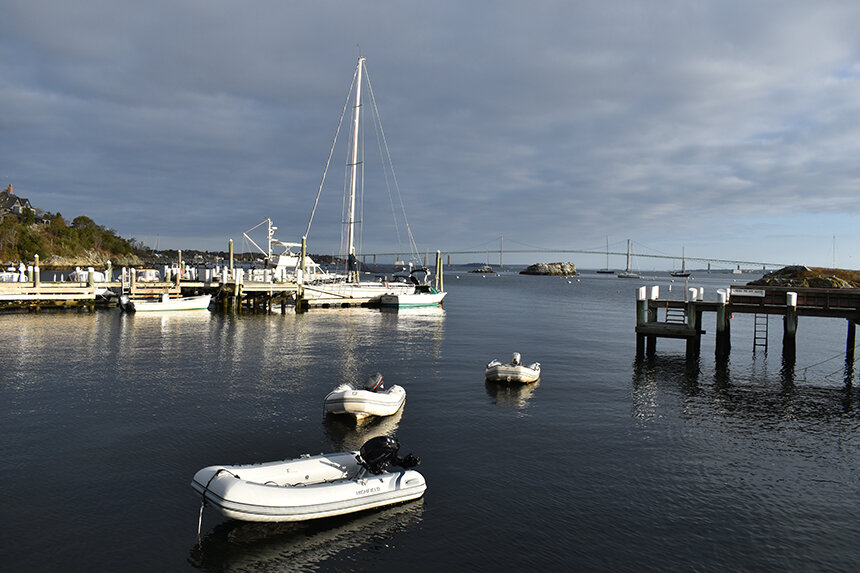New Housing Issue Complicates R.I.’s Solar-Siting Plans
Developers upset they are losing land to ground-mounted solar projects
June 13, 2019
PROVIDENCE — The already-controversial issue of open-space protection and solar sprawl is getting more complex.
On May 29, the Senate Committee on the Environment and Agriculture passed a bill (S0661) to the Senate floor that requires solar-siting standards for every city and town in Rhode Island. The bill, however, has yet to be scheduled for a vote by the full Senate.
Committee chairwoman Susan Sosnowski, D-South Kingstown, amended her bill to what she called “a pared-down version” of the original legislation. Gone from the bill is a10-megawatt cap for solar projects on land zoned residential. Also cut was a 4-megawatt limit on projects in areas of environmental concern, which are typically 250 acres or more of forestland. Incentives for building solar in less environmentally sensitive locations such as a commercial properties, landfills, gravel pits, and brownfields were removed.
A controversial requirement, added at the request of home-builders, was also removed. The stipulations required municipalities to replace land converted to ground-mounted solar by setting aside new land zoned for residential development.
All that remains in the Senate bill is a requirement that every city and town establish solar-siting rules by April 30, 2020. Failing to do so would result in the community losing use of two state solar incentives, the Renewable Energy Growth Program and the Renewable Energy Fund. The prohibition would only apply to projects larger the 25 kilowatts, which is the size of a large residential solar installation.
The future of the Senate bill and a House version (H5789), which still contains all of the proposed restrictions and incentives, seems less certain as the General Assembly nears the end of June, the traditional end of the legislative session.
What may pass is a Senate study commission to address the issue of housing lost to solar development. Sosnowski said housing received little attention during the nearly two years an advisory group of 37 stakeholders, led by the Office of Energy Resources (OER), has been debating solar siting. The ongoing effort included a dozen public meetings. Now some municipalities and developers are troubled about losing land that could be used to build new homes, Sosnowski said.
A bill creating the study commission hasn’t been introduced, but Sosnowski said at the May hearing that a Senate panel would be formed to “address how housing in our community is being displaced by renewable-energy projects. … It’s a very important issue on both sides, both sides.”
As of May, at least 20 cities and towns in Rhode Island have set rules for solar installations, while 19 lack solar siting ordinances, according to OER.
Some communities are rewriting ordinances after learning they can’t control solar sprawl. Developers are skirting a rule that limits solar projects to 10 megawatts of electricity capacity by subdividing a single parcel into separate solar projects, each below the 10-megawatt threshold. In North Smithfield, the loophole is being used to split a proposed 43-megawatt solar facility on a 400-acre site into nine contiguous projects.
Hopkinton, a rural community at the epicenter of the solar-siting debate, has a stringent solar-building ordinance, but it’s being circumvented by developers who receive zoning exemptions from the planning board. Other communities such as Cranston and Tiverton are wrestling with temporary moratoriums on solar construction.
Groups like Grow Smart Rhode Island are calling for the state to do the planning for open-space protection. They advocate for so-called “smart growth” municipal planning, such as the provision in the House bill that offers incentives for building in commercial areas and on brownfield sites. Scott Millar, manager of community technical assistance for Grow Smart Rhode Island, favors an approach used by Vermont, where the state designated sites for solar development.
Millar wants a statewide moratorium on all ground-mounted solar projects 1 megawatt or larger in size and zoned for residential sites.
“Those are the projects that are creating the most environmental problems,” Millar said.
The solar-siting bills have created a rift among environmental groups, many of whom serve on the OER’s solar advisory board. They are at odds over the loss of open space and forests and the need for renewable energy to curb climate emissions. The Conservation Law Foundation, The Nature Conservancy, the Northeast Clean Energy Council, and the Acadia Center see the bill as much-needed action this year that will stem the loss of woodlands.
In addition to Grow Smart Rhode Island, the bills are opposed by Save The Bay, the Rhode Island Tree Council, and the Rhode Island Chapter of the American Planning Association. These groups say the bills fail to curb the power-pricing incentives, such as virtual net metering, that result in clearing trees to build solar facilities in natural habitat.
“Instead, meaningful incentives should be provided to encourage subsequent solar in areas that have already been developed or disturbed,” Millar said.
But the Acadia Center say communities are overwhelmed with solar projects and urgently need help to address the deluge of projects.
“We’re still very much urging more comprehensive action on solar siting this year,” said Erika Niedowski, Rhode Island director for the Acadia Center. “The status quo is not serving anyone well.”
Categories
Join the Discussion
View CommentsRecent Comments
Leave a Reply
Your support keeps our reporters on the environmental beat.
Reader support is at the core of our nonprofit news model. Together, we can keep the environment in the headlines.
We use cookies to improve your experience and deliver personalized content. View Cookie Settings




How on earth can South Kingston, a town so economically dependent on maintaining a healthy environment—fishing, aquaculture, tourism—keep voting for such a stool pigeon for the construction industry as Susan Sosnowski?
Political action on behalf of the state’s environment desperately needs a retooling. Protest is ineffective if not accompanied by a statewide, town by town, electoral strategy. We need to find and elect strong local candidates for the Statehouse and retire the Sosnowki’s, the current political leaders who could give a damn when we show up at the Statehouse waving placards and shouting slogans.
And Gina Raimondo’s silence on this issue deafening, too, is it not?
One of the big issues missed in the discussion period videoed above, in reference to the site of the big North Smithfield project, is the question of what constitutes an "environmentally sensitive area." That is the vague term that keeps getting batted about as if it were in fact a term of art. Fact is, DEM and The Nature Conservancy have been meticulously mapping Rhode Island’s environmentally sensitive areas at least since the massive 1995 RI Resource Protection Project. And since 2005, RI DEM and The Nature Conservancy have aligned their terms of art with that of every other state that has created and maintained a Wildlife Action Plan in order to comply with US Fish and Wildlife Service requirements when applying for matching Federal money for the purchase of conservation land, ie. wildlife management areas, etc.
Yet, when land use and energy professionals talk about the environmental trade offs of forest sited solar, about all you hear is "Too bad we have to cut down so many trees," and the rejoinder voiced above that "Well, an acre of solar panels is going to cut a heck of a lot more carbon emission than an acre of trees will absorb."
As scientific an observation as that apparently is, it overlooks the crucial point that 1 acre of woods over here is not nearly as ecologically valuable that acre over there. The one might be sacrificed, the other demands protection. And that data to make that choice is available and easily understood the digital "Conservation Opportunity Areas" map in DEM’s 2015 Wildlife Action Plan.
And, the solar siting guidelines we have right now, promulgated by the RI Division of Planning, states that the WAP’s COA map is the essential reference work available for towns and their hired professionals to use.
Yet, we keep hearing about "environmentally sensitive areas" instead of the precise nomenclature. The North Smithfield project, for example, is sited on top of two such areas, one sensitive and the other very sensitive: a "Unfragmented Forest block 500 acres+" and a "Natural Heritage Area" which means a habitat surrounding the documented findings of "State-listed" species—species under a significant category of threat that ranges from "endangered" to "threatened" to "of concern."
And the lack of interest in or knowledge of this essential land use planning tool among RI towns surfaced in the Energy Facility Siting Board board hearings on the Burrillville power plant. Invenergy, in cross examining a DEM official, made much of the apparent lack of interest in the RI WAP exhibited by western RI towns.
Yes, that’s because the developers are allowed to control this debate. The comparison between cutting carbon emissions vs carbon sequestering is specious at best. Even developers admit that forests help us fight climate change by absorbing carbon, so why target them? Why isn’t the statehouse giving incentives for solar development on disturbed land that is NOT absorbing carbon (ask Susan Sosnowski!)? It’s because developers say it’s more expensive to develop on brown fields, etc., and that would reduce their profits. It has become very clear that profits are the true objective of solar sprawl – neither the developers nor our state reps are in it for the environment! Your point is also important because nearly all of the utility scale solar development (in Hopkinton, at least) is sited over aquifers, and we are supposed to ignore the fact that forests protect water quality. Oh well, who needs clean drinking water? Finally, show me a single RI politician who cares about wildlife habitat!
Hopkinton’s Town Council is circumventing the whole process and ignoring the citizens and their own planning board. The planning board is trying to do the right thing and being ignored along with the citizens. The council is ramming through all they can even land in the newly named Wood Pawcatuck Wild and Scenic Rivers area.
It is NOT the Hopkinton zoning board that is giving developers zoning exemptions; it is the Town Council! The zoning board has been opposed to the utility scale solar development in residential areas because it is "spot zoning" and does not comply with the town’s Comprehensive Plan. I would love to see some investigative reporting on the relationship between some council members and landowners who stand to benefit from approval of these developments.